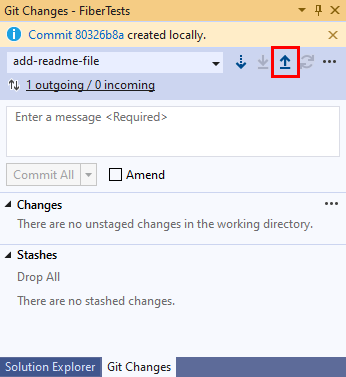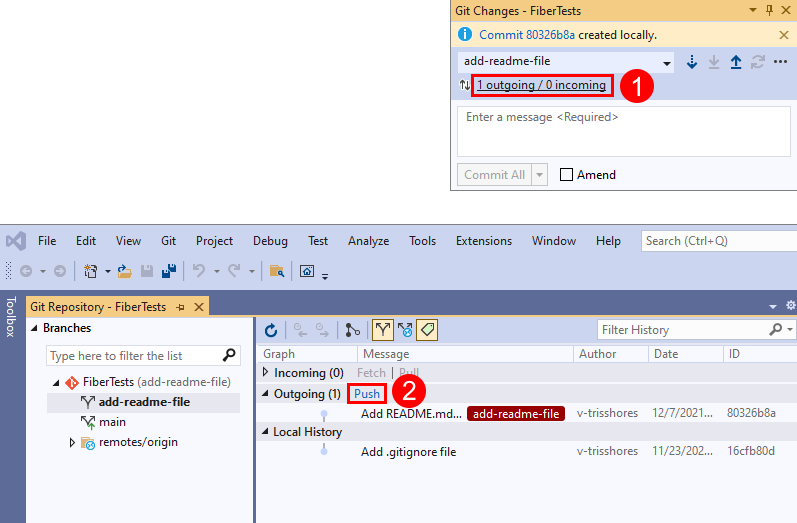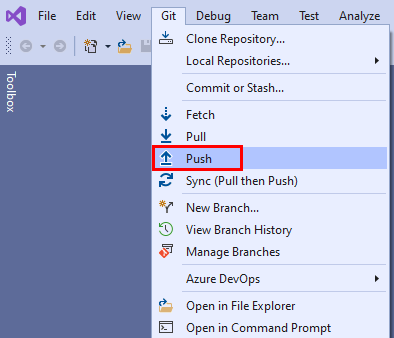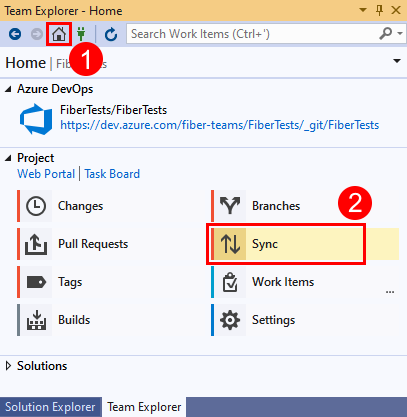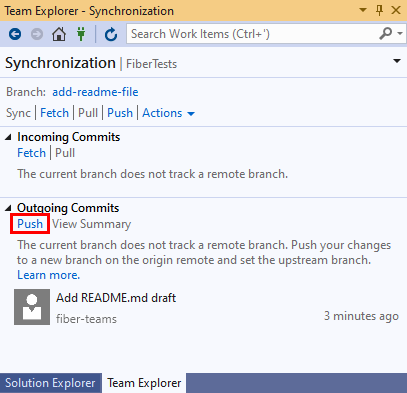Share code with push
Azure DevOps Services | Azure DevOps Server 2022 - Azure DevOps Server 2019
Visual Studio 2019 | Visual Studio 2022
You can share your work on a local Git repo branch by uploading your changes to a remote repo that others can access. The Git push command uploads new commits from your local branch to the corresponding branch of a remote repo. Visual Studio uses the push command when you choose to sync your work with a remote repo.
For an overview of the Git workflow, see Azure Repos Git tutorial.
Prerequisites
| Category | Requirements |
|---|---|
| Project access | Member of a project. |
| Permissions | - View code in private projects: At least Basic access. - Clone or contribute to code in private projects: Member of the Contributors security group or corresponding permissions in the project. - Set branch or repository permissions: Manage permissions permissions for the branch or repository. - Change default branch: Edit policies permissions for the repository. - Import a repository: Member of the Project Administrators security group or Git project-level Create repository permission set to Allow. For more information, see Set Git repository permissions. |
| Services | Repos enabled. |
| Tools | Optional. Use az repos commands: Azure DevOps CLI. |
Note
In public projects, users with Stakeholder access have full access to Azure Repos, including viewing, cloning, and contributing to code.
| Category | Requirements |
|---|---|
| Project access | Member of a project. |
| Permissions | - View code: At least Basic access. - Clone or contribute to code: Member of the Contributors security group or corresponding permissions in the project. |
| Services | Repos enabled. |
Push your code
After you've added one or more commits to a local branch, you can "push" the commits to a remote branch to share or back up your work. When you use the push command, Git checks whether your local branch is up to date with the remote branch. If not, Git will prevent you from pushing new commits until you've updated your local branch. To resolve this issue, you can pull to get the remote branch commits that aren't present in your local branch. If the pulled remote commits conflict with your local commits, try resolving those conflicts before pushing your changes.
For the Git push command to work, your local repo must be connected to a remote Git repo. If you cloned your local repo from a remote repo then they're already connected. But if you created your local repo without cloning, you'll need to connect it to a hosted Git repo. For more information, see Connect to an Azure Repos Git repo and Connect to a GitHub repo.
Tip
To support a pull request review of your work, avoid working directly in the main branch of your local repo. Instead, save your commits to a local feature branch or bugfix branch, and push that branch on completion of your work. For an overview of the Git workflow, see Azure Repos Git tutorial.
- Visual Studio 2022
- Visual Studio 2019 - Git menu
- Visual Studio 2019 - Team Explorer
- Git Command Line
Visual Studio 2022 provides a Git version control experience by using the Git menu, Git Changes, and through context menus in Solution Explorer. Visual Studio 2019 version 16.8 also offers the Team Explorer Git user interface. For more information, see the Visual Studio 2019 - Team Explorer tab.
In the Git Changes window, select the up-arrow push button to push your commit.
Or, you can push your changes from the Git Repository window. To open the Git Repository window, select the outgoing / incoming link in the Git Changes window.
Or, you can push your changes from the Git menu on the menu bar.
Once you've pushed your commits, you can create a pull request to let others know you'd like to have your changes reviewed. If approved, your changes will be merged into a target branch of the remote repo.
